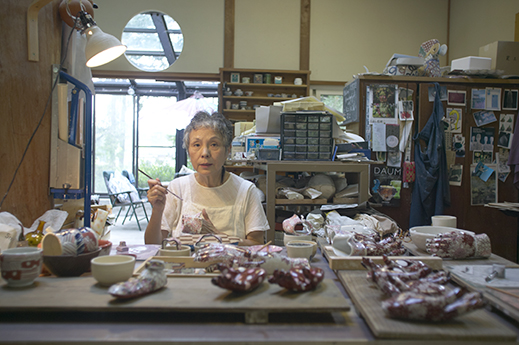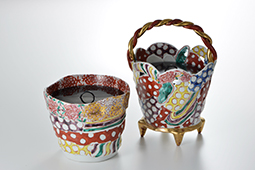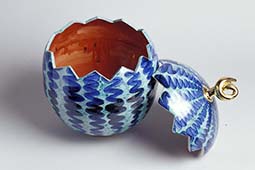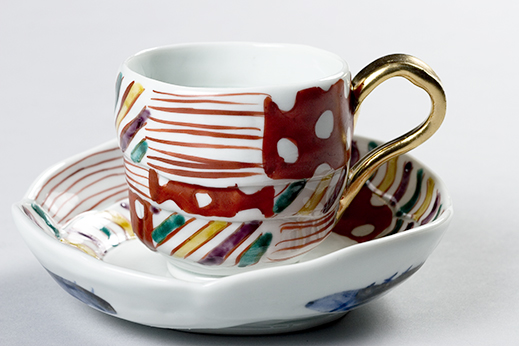 |
Fuji-san: First Dream of the New Year: Mt. Fuji, Hawk and Eggplant (2014), porcelain with overglaze enamel and gold decoration. |
Call her works playful. Call them sensuous. Call them decorative, even, and ceramic artist Yuriko Matsuda won't mind a bit. "It's such a shame that the term 'decoration' is so often applied as a pejorative," Matsuda said in a recent interview, using the Japanese word soshoku. "The implication seems to be that anything that is decorative or ornamental can't be real art, because it lacks depth and meaning. I couldn't disagree more."
 |
The artist at work in her studio in Oshino, Yamanashi Prefecture. She has a stunning view of Mt. Fuji out the back window. |
For nearly half a century, Matsuda has fashioned unlikely objects out of porcelain clay -- everything from bare feet and ladies' bums to watering cans and garden vegetables. She decorates her forms lavishly, covering them with brightly colored patterns that reference traditional Chinese and Japanese porcelain. In doing so, she says, she is seeking the original meaning and intrinsic power of decoration.
 |
La Prière (The Prayer), an homage to Man Ray (1988). |
Born in 1943, Matsuda entered Kyoto City University of the Arts in 1962 intending to study painting. But a professor steered her towards ceramics, cautioning that it was hard for anyone to make a living as a painter, and more so for a woman. She studied porcelain making under Kenkichi Tomimoto (1886-1963), the founder of the university's ceramics department and an influential figure in postwar Japanese ceramics. While still a student, Matsuda travelled to Ishikawa Prefecture to learn Kutani overglaze painting techniques from master potter Tojiro Kitade, and to Tobe, in Ehime Prefecture, to study sometsuke blue underglaze.
 | |
Watering Can (2009). |
In 1973 Matsuda made her debut at the Japan Ceramic Art Exhibition (Nihon Togeiten), a juried show launched two years earlier by the Mainichi Newspapers Co. as an alternative to established shows in which free competition was seen as impeded by factionalism and regional biases. For the next decade, her work was selected each time the biannual exhibition was held, for inclusion in the avant-garde section. While this exposure launched her career, Matsuda doesn't think of herself or her work as avant-garde.
"Keep in mind that I don't make abstract forms; everything I make is something recognizable," she pointed out. "And in my materials, motifs, and some of my subjects, I'm generally within the Japanese ceramic mainstream." Certainly, in choosing Mt. Fuji as a frequent theme, Matsuda is following a well-established path set down by countless Japanese artists before her. Even so, she has managed to find an original take on an old theme -- her depictions of the sacred mountain often feature a banana or eggplant perched on top, a touch that may at first seem incongruous, yet is firmly rooted in traditional Japanese aesthetics.
 | |
In Her Shoes (2007). |
For nearly 50 years, Matsuda has worked in Oshino, Yamanashi Prefecture, a perfect location from which to observe the mountain. The view of Mt. Fuji changes with the light and the weather, and sometimes disappears completely. Frequently captivated by the sight of the crescent moon rising over the tip of the peak, she decided to reproduce that view in her own way. "Some people have taken issue with my Mt. Fuji pieces, offended that I should place a common fruit or vegetable atop such a sacred mountain. But in fact I am following a long tradition in Japanese art, called mitate, of playfully representing something with something else. Such unexpected juxtapositions are particularly valued in the aesthetics of the tea ceremony, which I greatly admire."
 |  | |
Mizusashi water jars for use in the tea ceremony. Left, a multicolor jar with lacquer lid and a footed jar with handle and lacquer lid (2014). Right, a watermelon-shaped, lidded water jar (1999). |
Throughout her career, Matsuda has created pieces that openly reference the work of other artists. "I don't believe it's possible, in this day and age, for an artist to work in a vacuum. We are inundated with images of other artists' work, from all eras and cultures," she observed. "Rather than fight outside influences, I embrace them." One of Matsuda's better-known works is an installation of a disembodied female posterior, flanked by separate pieces that represent a woman's bare feet. Made of porcelain, the surfaces of all three pieces are covered with patterns from Chinese porcelain of the Ming Dynasty. Her initial inspiration for this came from a photograph of a naked woman in a similar pose, taken in 1930 by American photographer Man Ray (1890-1976). As homage, Matsuda gave her work the same title: "La Prière" (The Prayer).
 |
Hand-built patchwork saucer and cup with gold handle (2012). |
Not wishing to be confined to cylindrical and symmetrical shapes, Matsuda does not work on a wheel. Instead she rolls her clay, which includes a mixture of porcelain stone from both Arita and Seto, and either works it into molds that she makes herself, or divides it into pieces that she presses together by hand for a layered, patchwork effect. She is not aware of any other ceramic artist who works with porcelain in quite the same way.
Thanks to exposure and contacts made during numerous overseas trips, Matsuda enjoys something of an international following. Her work was part of an exhibition organized by the Japan Foundation in 1983 that presented over 300 works by 100 living Japanese ceramists. At the time, it was the largest and most important international show of contemporary Japanese ceramics, and travelled to major venues in both Washington, D.C. and London. Matsuda's work has also been shown in Italy, France, Belgium, Eastern Europe and Egypt, and was included in the Japan Society of New York's exhibition of contemporary Japanese ceramics in 2006-2007. Examples of her work are in the collections of the Brooklyn Museum, the Yale Art Gallery, the Spencer Museum of Art at the University of Kansas, and the University of Hawaii Art Gallery, as well as many major museums in Japan.
| All photographs are courtesy of the artist |